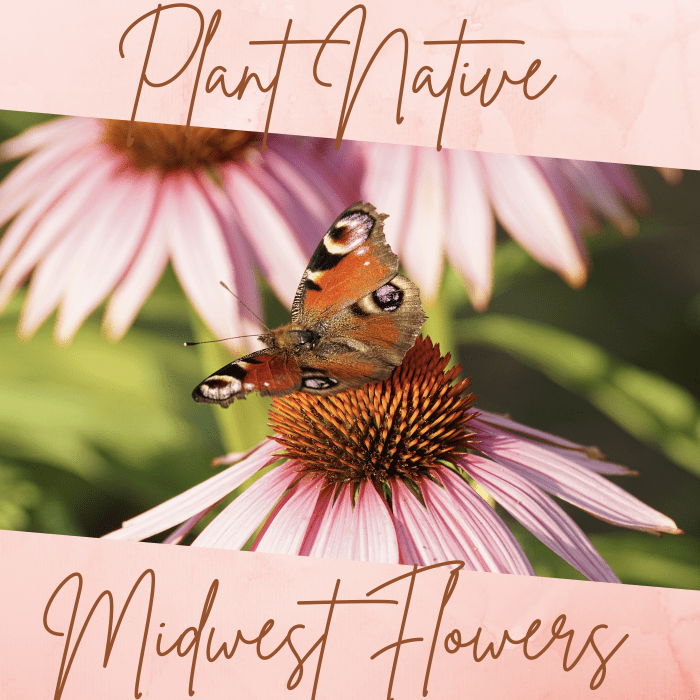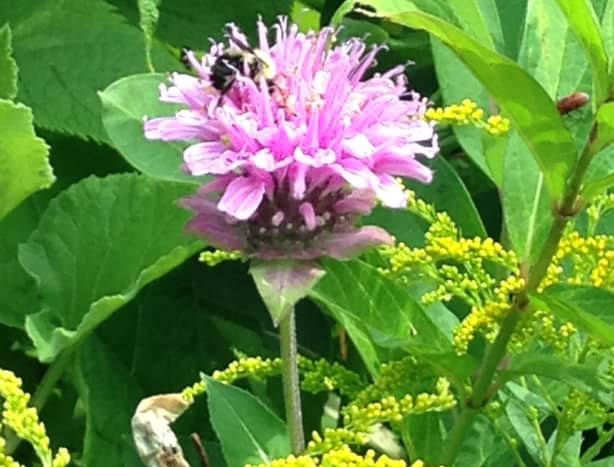Ideas For Midwestern Usa Native Plant Gardens
Chantelle has been gardening since the age of 12 when she was responsible for weeding her parents 22,000-square-foot garden each summer.

Plant native midwest flowers, like echinacea, to revive the environment and restore native ecosystems.
Image by suju-foto from Pixabay; Image created with Canva
Why Plant Natives?
- They are perfectly suited to their environment. They have spent centuries adapting to the soil, sun, and climate of your geographic location. This gives them a hardiness that can't be purchased at a garden store.
- They attract beneficials, as in bugs, toads, birds, snakes, bunnies, and anything else that eats their seeds, basks in their shade, and finds protection in their midst. They will change the ecosystem of your yard to bring it back into harmony with the environment.
- They don't require fancy fertilizers to stay alive. They are planted where they belong and are ideally suited to extracting what they need from the environment and don't require any artificial anything.
- They are healthier than a traditional lawn. They don't require pesticides to rid themselves of weeds and are safe for kids, pets, and birds.
- Once established, they require no watering—ever.
- They are simply beautiful. Read below for eleven that are ideally suited to the Midwest.
11 Native Midwest Flowers
- Bee Balm
- Echinacea
- Common Milkweed
- Culver's Root
- Butterfly Weed
- False Sunflower
- New England Aster
- Joe Pye Weed
- Goldenrod
- Whorled Milkweed
- Black-Eyed Susan

1. Bee Balm
Monadarda fistulosa (wild bergamot), commonly referred to as bee balm at garden centers, is a member of the mint family. It grows three feet tall with profuse lavender flowers that grow at about an inch across. The leaves of this plant have a distinctly pleasant minty odor.
A full sun plant, bee balm is susceptible to powdery mildew when planted too closely together. Powdery mildew is a fungus that, while not dangerous, is unsightly. Space plants according to planting directions (about 18 inches apart) to keep plants healthy.
Monarda grows in the wild from Quebec in the North to Texas in the South and all over the Midwest. It has a long history of being used for medicinal purposes by Native Americans who boiled it into a tea (bergamot tea) to treat colds and as an antiseptic to speed wound healing.
Monarda fistulosa grows by rhizomes and can spread quite quickly. If giving it space to spread is not an option, plant it in an extra-large planter sunk into the ground to keep it from spreading.
Companion Plants
Plant with companions goldenrod and daisies for a dainty look that's tough as nails.

2. Echinacea
Echinacea, also referred to as the purple coneflower, is found in the middle latitudes of the US from the Eastern seaboard to the central US. Purple coneflowers are part of the daisy family and are found on the prairie or dry grasslands. The "cone" portion of the flower is about 1.5 inches across and with petals is about 4 inches across. They bloom from the end of June through August and reach a height of about four feet.
Echinacea was used by the Plains Indians to ease the symptoms of medical problems ranging from snakebites, coughs, and sore throats to headaches. Today, echinacea is marketed as a cold relief "medicine" though there is no conclusive evidence that it can treat or prevent the common cold.
Echinacea does not spread the way monarda does but if the flower head is left to turn to seed new plants will sprout in the spring.
Companion Plants
Group with daisies and salvia and wait for the compliments from your neighbors.

3. Common Milkweed
The common milkweed is found all over the Midwest and grows primarily in sun. It can reach over 6 feet high and the leaves range anywhere from 4–10 inches long. The flowers are small but clustered together in groupings that are about 3 inches across. This plant spreads by seeds as well as by rhizomes and is great as a back of the border plant.
The milkweed plays a critical role in the lifecycle of the monarch butterfly. The larvae are deposited onto the underside of the leaves and the milkweed is used as a food source. Adult monarchs also dine on the milkweed's nectar. Planting common milkweed is critical to ensure the survival of the monarch butterfly as it is the only plant where it deposits its eggs.
Companion Plants
Common milkweed looks great mixed with some native grasses or false sunflowers.

4. Culver's Root
Culver's root (Veronicastrum virginicum) has long tapering flowers that are about 9 inches long on a stem reaching about 6 feet in height. It blooms from July through August and is much beloved by honeybees.
Culver's root is a native of Illinois' tallgrass prairie. It gets its name from Dr. Culver, an 18th-century physician who used this plant extensively in his practice. Many Native American tribes used Culver's root to stop nosebleeds and as an emetic. Related to digitalis, it can be harmful if ingested.
Read More From Dengarden
Companion Plants
Culver's root looks lovely combined with coneflowers, wild quinine, and butterfly weed.

5. Butterfly Weed
Butterfly weed (Asclepias tuberosa) is a beautiful fiery orange flower that grows in full sun to about 30 inches tall. It blooms from June to August and is very drought tolerant as well as a rabbit and deer-tolerant plant. This plant will self-sow. Removal of the seed pods prior to their opening will prevent this. Otherwise, expect new shoots in the spring.
The flowers are a food source for many butterflies hence the name. It has also been referred to as pleurisy root from the practice of chewing the roots to treat lung inflammation.
Companion Plants
Mass butterfly weed to produce drifts that are particularly attractive to butterflies. This plant looks lovely combined with echinacea as well as daisies.

6. False Sunflower
False sunflower (Heliopsis helianthoides) is a perennial plant that is a member of the aster family. A somewhat bushy plant, it grows to between 3–5 feet tall and has a flowerhead that has 8–20 ray florets. Each individual flower is approximately 1.5 inches across
The false sunflower prefers full to part sun and is easy to grow. It has a long blooming period during the summer and attracts a variety of insects including honeybees, bumblebees, wasps, and painted lady butterflies. Gamebirds, songbirds, and small rodents have been known to eat their seeds.
Companion Plants
The false sunflower makes a cheery addition to any garden and looks wonderful accompanied by echinacea and native grasses.

7. New England Aster
A native in all but 6 US states (Idaho, Nevado, Arizona, Texas, Louisiana, and Georgia), the New England aster (Aster novi-angliae) prefers full sun but can tolerate part shade. Growing almost 6 feet tall and 2 feet wide, it ranges in color from light pink to deep purple and blooms from the end of summer to early fall. Asters are susceptible to powdery mildew so make sure they have plenty of air circulation.
Companion Plants
Rabbits love Aster buds so protect your plant with a cage before it has matured. Combined with echinacea and daisies it makes for a lovely tableau.

8. Joe Pye Weed
Joe Pye weed (Eupatorium purpureum) is a native of the US and Canada and a member of the sunflower family. Joe Pye weed grows from 3–12 feet tall and is crowned with beautiful pinkish-purple flowers that last from mid-summer to fall. It is hardy in USDA Zones 4–9.
Joe Pye, an Indian healer from New England, used the plant to treat a wide variety of ailments which led to the plant being named after him. Folklore states that Joe Pye weed was used to treat fevers, typhus, kidney stones, and urinary tract ailments.
Companion Plants
Joe Pye weed is a back-of-the-border plant, requiring minimal care. As it is a clumping plant give it room to spread. Plant it with native grasses and wild quinine for a naturalistic look.

Goldenrod and Prairie Gentian
9. Goldenrod
Goldenrod (Solidago) is a common flowering perennial and member of the aster family found throughout North America in open areas like meadows and prairies. They thrive in full sun, growing to about 3 feet tall and blooming in late summer to early fall.
It is often assumed that goldenrod causes hay fever in humans. This is not the case. Hay fever is caused by ragweed which blooms at the same time as goldenrod but is wind-pollinated. Goldenrod is pollinated by insects.
Companion Plants
While considered a weed by many in North America they are widely popular in Europe. Plant with Rosa rugosa, native grasses, and pink sedum for a lovely garden bed with a romantic feel.

10. Whorled Milkweed
Whorled milkweed (Asclepias verticillata) grows to about 2 feet tall with leaves 2–3 inches long and clusters of flowers with each bloom about 0.5 inches across. It is a summer bloomer and prefers full sun though during hot dry weather their leaves may turn yellow or fall off. This plant can spread in open sunny areas.
The nectar attracts a variety of bees, wasps, flies, and butterflies. Mammals avoid the Whirled milkweed as it is quite toxic. Though a native it is relatively rare to find it growing in the wild. A native plants nursery should carry it however it would be the rare general garden center that would stock it.

11. Black-Eyed Susan
Rudbeckia fulgida, often referred to as a black-eyed Susan, is one of the top-selling perennials in the country. Rudbeckia, with its many variants, is found all over the US. Easy to grow, requiring full sun and good drainage, Fulgida will grow to 30 inches and will bloom from July to October.
Companion Plants
A true meadow and prairie plant, they shine when planted with large swatches of ornamental grasses and other late-blooming perennials like New England aster. They are good nectar plants and are sought out by butterflies and other insects. They are drought tolerant once established.
Tips Before You Plant
- Sketch out your garden plan on paper. This will help you visualize where plants should be placed and determine how many in total you will need.
- Plant your natives in drifts. Large sections of one plant are more likely to attract the attention of the birds and insects that rely on the plants for food and shelter.
- Plant your drifts in odd numbers ( i.e. 5 plants not 4). It is more aesthetically pleasing to the eye.
- Start small. Your lawn, once you've dug it up, will need to be planted with something—right away. Don't overwhelm yourself and get discouraged because you've taken on too much. Baby steps.
- Now sit back, relax and enjoy the beauty that nature has to offer.
This content is accurate and true to the best of the author's knowledge and is not meant to substitute for formal and individualized advice from a qualified professional.
© 2015 Chantelle Porter
duyve5@att.net on May 12, 2019:
where can we buy native flowers.....In the Quad Cities, IL and IA
Chantelle Porter (author) from Ann Arbor on September 27, 2015:
Thanks for stopping by.
praireflower on September 27, 2015:
You've given me a lot to think about. Really enjoyed this article.
Chantelle Porter (author) from Ann Arbor on July 22, 2015:
Thank you. Glad you enjoyed it.
Sherry Hewins from Sierra Foothills, CA on July 22, 2015:
There certainly are a lot of benefits to using native plants. This is a very informative article.
Ideas For Midwestern Usa Native Plant Gardens
Source: https://dengarden.com/gardening/Beautiful-Maintenance-Free-Natives-For-Your-Midwestern-Garden
Posted by: ballthismillond.blogspot.com

0 Response to "Ideas For Midwestern Usa Native Plant Gardens"
Post a Comment